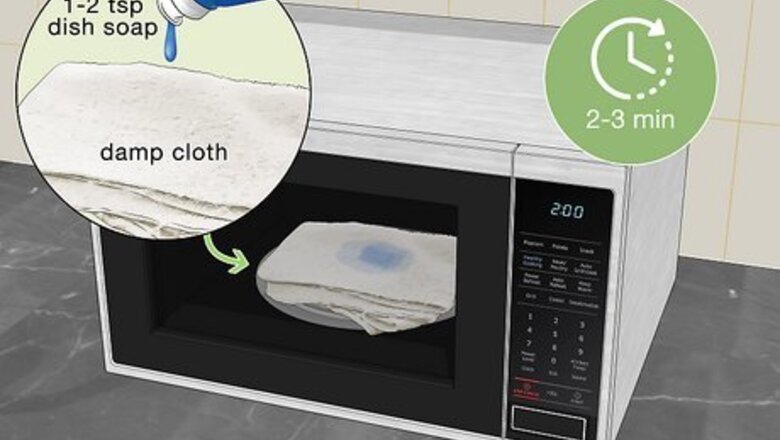
views
- Get rid of fishy smells by wetting a clean cloth with water and a squirt of dish soap. Heat the cloth for 2–3 minutes in your microwave before wiping the inside.
- Eliminate odors with a solution of water and either lemon juice, vinegar, or rubbing alcohol. Boil the solution in the microwave and let it sit for 15 minutes.
- Place a bowl of baking soda or used coffee grounds in your microwave when you aren’t using it to absorb burnt food odors.
Neutralizing Microwave Smells
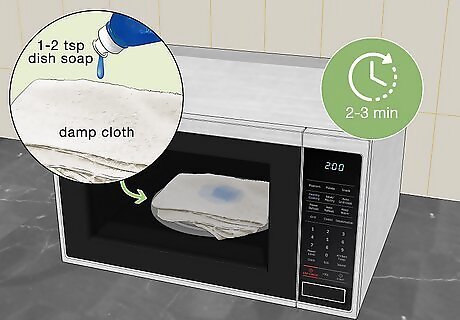
Add dish soap to a damp cloth and microwave it to remove fishy smells. Wet a dishcloth and squeeze 1–2 teaspoons (4.9–9.9 ml) of dish soap onto it. Set the dishcloth in your microwave and let it run on high for about 2–3 minutes. Give the cloth 30 seconds to cool before using it to wipe down the walls of your microwave to completely get rid of the odor. The water and soap clean your microwave with steam and leave behind a pleasant smell.
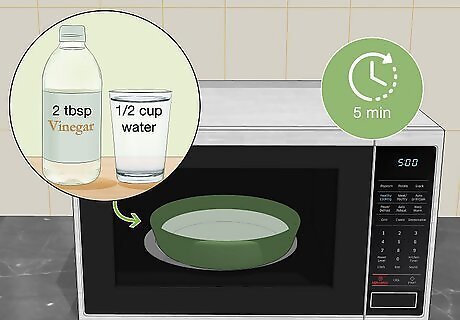
Microwave vinegar and water to eliminate lingering food smells. Fill a microwave-safe bowl with 2 tablespoons (30 ml) of distilled white vinegar and ⁄2 cup (120 ml) of water. Place the bowl in your microwave and run it on high for about 5 minutes. Let the bowl sit in your microwave with the door closed for 15 more minutes before taking it out. Then, just use a soft cloth or paper towel to wipe away any residue in your microwave. Vinegar naturally neutralizes strong odors, and the steam from heating it up will help loosen any stuck-on food that may be causing the smells. Try adding in 1 tablespoon (15 ml) of vanilla extract to the vinegar solution to make your microwave smell better.
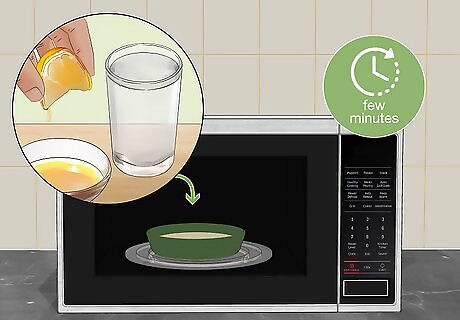
Heat a lemon juice solution in your microwave for a fresh citrusy scent. Pour ⁄2 cup (120 ml) of lemon juice and 1 cup (240 ml) of water into a microwave-safe container. Place the container in your microwave and heat it up for a few minutes until the solution comes to a boil. Leave the door closed so the steam builds up inside your microwave to loosen old food and mask the unpleasant odors. Once the solution cools down, take it out and wipe the inside of your microwave with a paper towel. Alternatively, cut a lemon in half and juice it into a microwave-safe bowl filled halfway with water. Put the lemon rinds in the bowl and microwave it for 5 minutes.
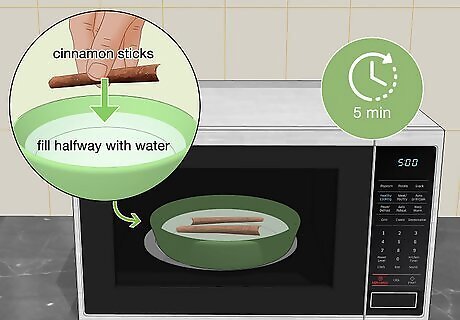
Boil cinnamon sticks or cloves in water for a nice spiced smell. Fill a bowl halfway with water and add in a few cinnamon sticks or a scoop of cloves. Run your microwave for about 5 minutes to bring the water to a boil. The smell of the spices will help mask the odors coming from your microwave and make your kitchen smell great. This trick smells great in the fall or around the winter holidays.
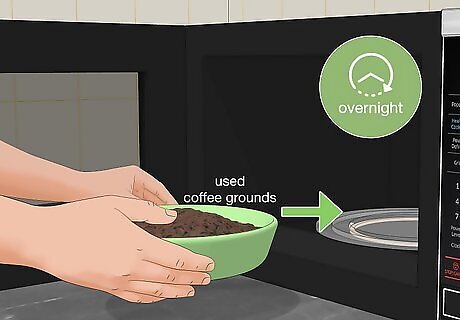
Place baking soda or coffee grounds in your microwave overnight. Pour 2 cups (272–544 g) of baking soda or used coffee grounds into a bowl and set it inside your microwave. Keep the microwave door closed overnight so the baking soda or grounds have a chance to absorb any residual odors that are inside. The next day, just toss the baking soda or grounds in the trash. Baking soda works great for removing a burnt or smoky smell from your microwave. Alternatively, mix 6 tablespoons (102 g) of baking soda with 1 cup (240 ml) of water and microwave the solution until it boils. Let the mixture sit inside your microwave with the door closed until it cools. Then, wipe the inside of your microwave with a soft towel.
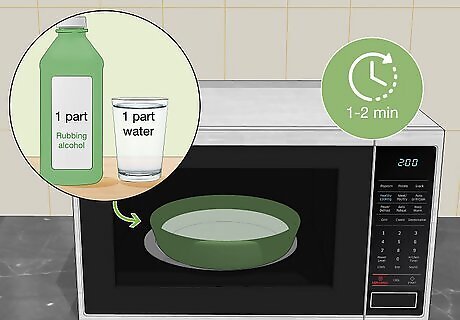
Try rubbing alcohol and water for odors caused by food residue. Mix equal parts rubbing alcohol and water in a bowl and pop it in your microwave for about 1–2 minutes. Once the solution steams up the inside of your microwave, dip a cloth in the mixture and scrub the walls, door, and turntable. Then, rinse the alcohol out by wiping it away with a damp cloth. Leave your microwave door open after you’ve finished cleaning so any residual alcohol odors air out.
Preventing Bad Odors
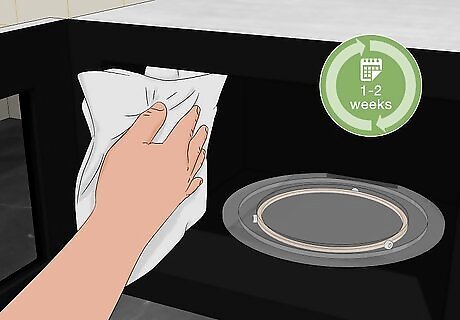
Clean your microwave every 1–2 weeks. Make it a habit every few weeks to clean food and residue off the inside of your microwave. Simply microwave a vinegar or lemon juice solution in your microwave until it boils and let the steam accumulate for 5 minutes. After that, follow up with a damp cloth to wipe all the surfaces inside. Dry your microwave off with some paper towels, and you’re all set to use it again. If you notice spills immediately after cooking, wipe them up right away to ensure they don’t leave residual odors or marks. You can use a commercial microwave cleaner instead of natural products. Spray the cleaner inside of your microwave and let it sit for the time listed on the package. Then, scrub the inside of your microwave with a clean cloth or sponge.
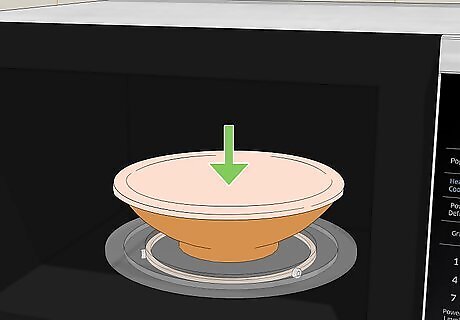
Put a cover over your food when you’re heating it up. Rather than just putting a plate or bowl in your microwave, place a plastic cover on top. Not only will the cover trap the odors so they’re less likely to stick in your microwave, but it will help your food stay moist and ensure it heats up evenly. A cover will also prevent food splatters from getting on the inside of your microwave, which can cause odors.
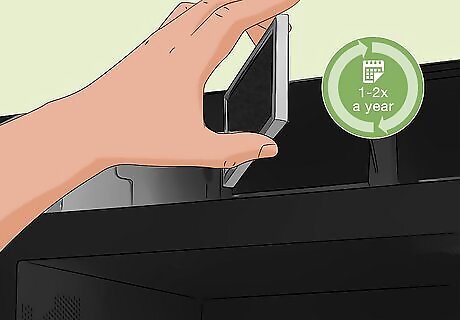
Replace your microwave’s charcoal filter 1–2 times each year. The charcoal filter helps absorb odors inside your microwave as your food cooks, but they cannot be cleaned. Filters are usually located on the bottom or top of your microwave behind a slotted panel. Unscrew the panel from your microwave and pull the square filter out. Then, put a new filter in its place. Consult the owner’s manual for your specific microwave to find where the charcoal filter is located and how to change it. If you don’t feel comfortable replacing the filter on your own, contact an appliance repair technician to do it for you.

















Comments
0 comment